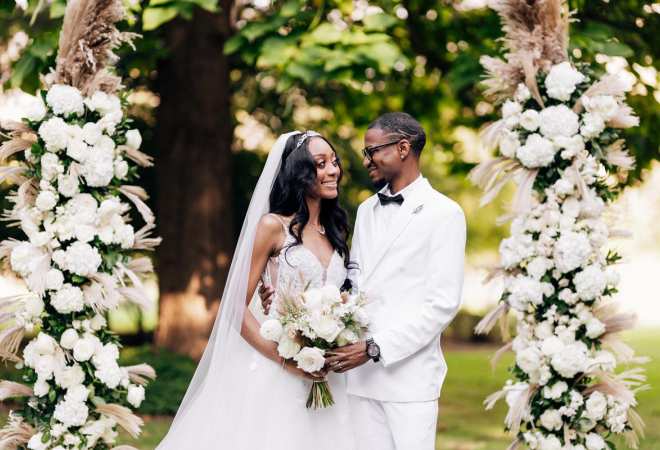If you love pearls, lace and tulle, you would have loved Gertrude Oliver's wedding gown. It had copious amounts of both, placed over white satin. The dress was ankle-length, but the train very long. It was rather simple in overall style, "made along old-fashioned lines," but heavily embroidered.
Gertrude, one of South Bend's most famous young women, was the second of four children born to J.D. Oliver, president of Oliver Chill Plow Works, and his wife Anna.
Her marriage to Charles Frederick Cunningham on September 30, 1916 was the talk of the town.
The Saturday night wedding took place at the First Presbyterian Church (now the Ambassadors for Christ Church), downtown at the corner of Washington and Lafayette streets. If you were in the wedding, you were somebody.
"Perhaps no event of recent seasons has equaled in brilliancy the marriage of Miss Gertrude Wells Oliver..." began the account in the Society News of the South Bend Tribune two days later.
Gertrude, just a few weeks short of her 28th birthday, had seven bridesmaids, all dressed in gowns of taffeta but in different shades of pink, from palest pink to deep rose.
And wow, did they decorate the church. According to the newspaper article, the altar "was transformed into a dense garden of fall lilies and greenery, a great central palm spreading its leaves almost to the ceiling and completely screening the choir loft."
Similarly transformed were the two aisles that lead to the altar of the church. The bride and her bridesmaids walked ceremoniously under "a pergola effect" created by ropes of asparagus fern stretched diagonally between tall white pillars, placed at intervals at the end of each aisle.
Lilies were everywhere-on the altar, on the pews and hanging from those tall pillars. The bride carried a bouquet of lilies and sweetheart roses and her bridesmaids carried bouquets of pink roses.
If the church was packed with people that night, even more so was Copshaholm, J.D and Anna's home on the west side of town. About 1,000 people were invited to the reception there.
"Guests would have been everywhere, except for the kitchen which would have been a beehive of activity," says David Bainbridge, senior curator for the Center for History. "And of course, it was a very 'in' crowd since J.D. was an international businessman. He had been to the White House several times, and Anna, Gertrude's mother, came from one of the oldest families in New York state. There were probably a good number of millionaires."
Those well-heeled guests would have entered through the front door and greeted the new married couple in the main room of the house-transformed, like the church, into a dense garden with greenery and lilies and cleared of all furniture.
Although there are no records of what food was served, we do know where and how it was served.
"The buffet dinner was served in the library and dining room, and they would have used all sections of the table, which is a total of six leaves," says Bainbridge.
The wedding cake was placed at one end of the table, but there are no records indicating what kind of cake Gertrude decided on or who would have designed or baked it.
"The cake could have come from Chicago, or it might have come from a local caterer," says Bainbridge. "There were a lot of local bakers at that time that did some very sophisticated things."
Someone must have thought the cake was quite grand, though, because a piece of it still exists. The brownie-sized portion, which now looks like a small dried brick, is stored in a small box and kept at Copshaholm. It is not part of any display at the Center for History.
At some point in the evening, the Blackstone Hotel (Chicago) orchestra started playing. The strains of a syncopated ragtime melody might have signaled to everyone that dancing had begun in the third-story ballroom.
Ballroom dancers might have done the turkey trot, a camel walk, a fast fox trot, or even the very newest of dances-the tango. Little did they know that this was the last time the ballroom would be used for dancing on a grand scale.
The gardens-now the site of many weddings-would have been full with lillies, fall clematis and pink roses along the walkways. Wedding guests would have strolled through them, admiring the immaculately-kept flower beds, and the sound of a working fountain.
Not much is known about the photographer for Gertrude's wedding. "There aren't a lot of photos because it was harder to take them back then. The technology for taking photos out of a studio had not been developed," says Bainbridge.
And they're not in color, because that technology had not been developed. The colors come alive, however, through details in the newspaper article, which talks about the yellow chrysanthemums used on the dining table, and Kilarney roses in the rose parlor.
The article also tells us that the new Mr. and Mrs. Cunningham made their future home in Lowell, Mass., where he worked for the United States Cartridge Company. (The two met in South Bend while he was working for another company and assigned to install an efficiency system at Studebaker.)
In their Massachusetts home, they would have used the gifts of silver and china given to them at the wedding reception. Those wrapped gifts were displayed in a room?probably a bedroom-adjoining the third-floor ballroom, while people danced, ate, conversed and congratulated the new couple.
In 1918, the Cunninghams moved back to South Bend because Mr. Cunningham became secretary and works manager for Oliver Chilled Plow Works.
But on the day of the wedding-as it is with all weddings-the focus was on flowers, the dresses, the food, the family and all their friends as they celebrated the new union.








Join the conversation
Log in or register to post comments